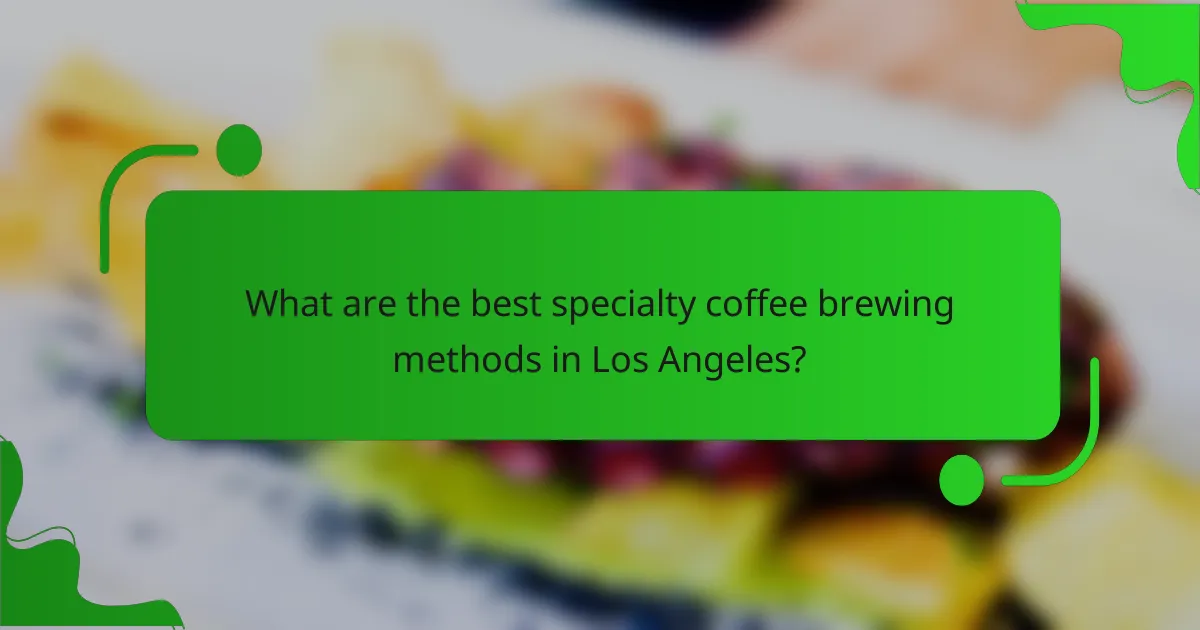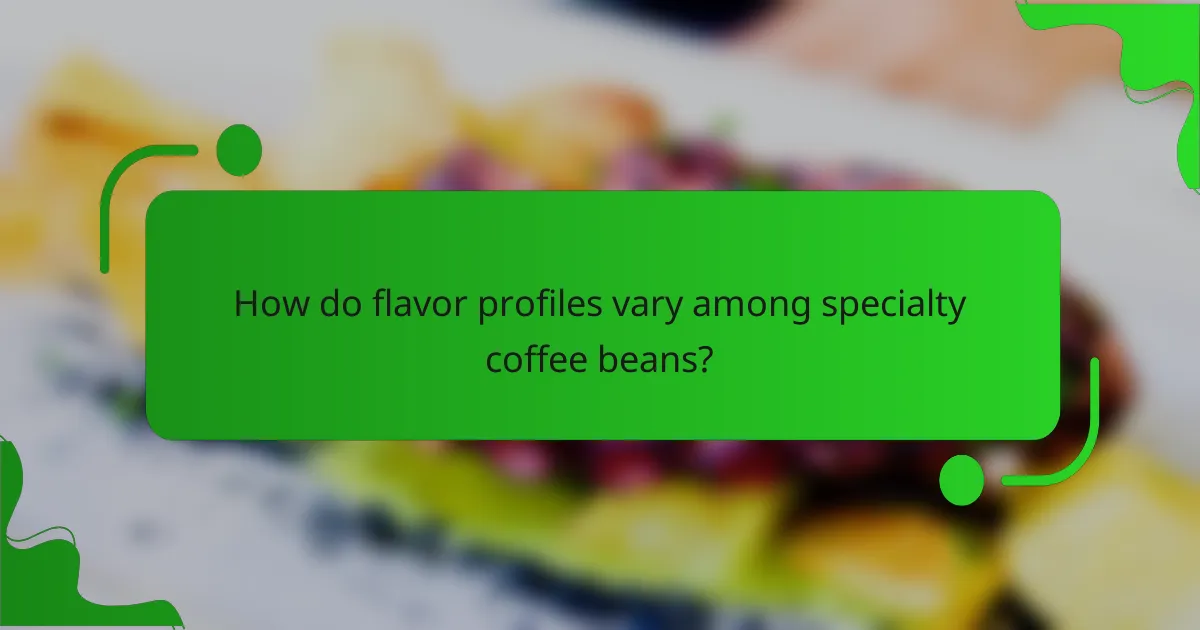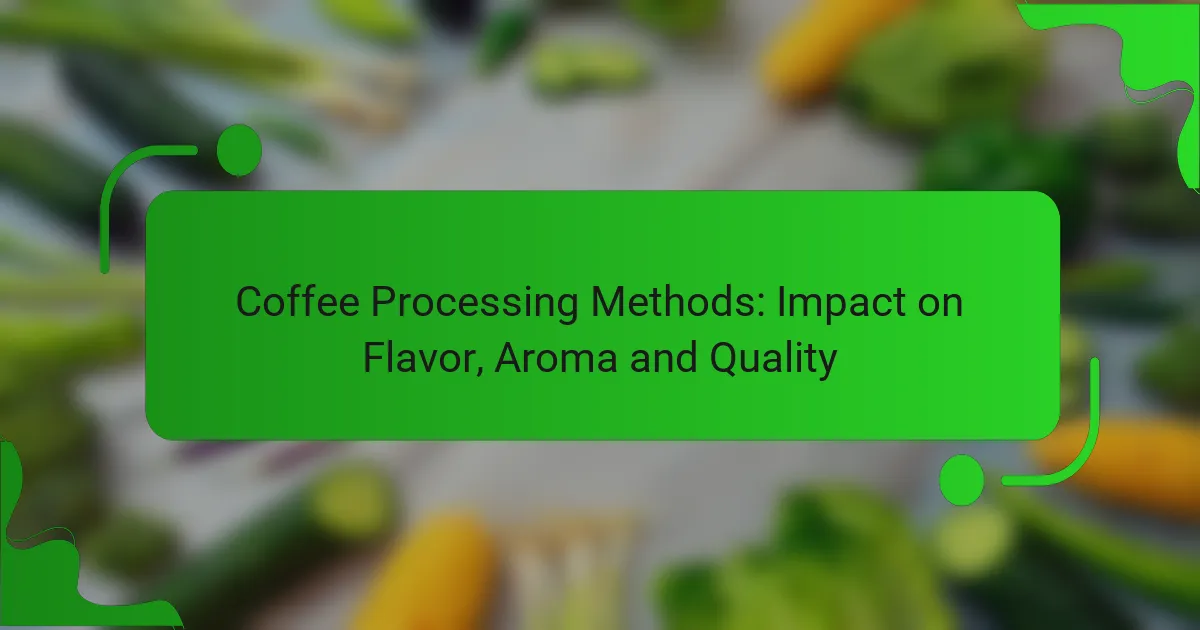Specialty coffee offers a rich tapestry of flavor profiles influenced by factors such as origin, processing methods, and roast levels. By exploring various brewing methods like pour-over, Aeropress, and cold brew, coffee enthusiasts can unlock distinct aromas and tastes. Additionally, thoughtful food pairings can enhance the coffee experience, creating a delightful balance that highlights the unique characteristics of each brew.

What are the best specialty coffee brewing methods in Los Angeles?
The best specialty coffee brewing methods in Los Angeles include pour-over, Aeropress, French press, espresso, and cold brew. Each method offers unique flavor profiles and brewing experiences, allowing coffee enthusiasts to explore a variety of tastes and aromas.
Pour-over brewing
Pour-over brewing involves manually pouring hot water over coffee grounds in a filter. This method allows for precise control over the brewing time and water temperature, resulting in a clean and flavorful cup. Popular pour-over devices like the Hario V60 or Chemex are widely available in Los Angeles coffee shops.
To achieve the best results, use a coffee-to-water ratio of about 1:15 and aim for a brewing time of 2-4 minutes. Avoid pouring water too quickly to prevent uneven extraction, which can lead to bitterness.
Aeropress brewing
The Aeropress is a versatile brewing device that uses air pressure to extract coffee flavors quickly. It’s compact and portable, making it a favorite among coffee lovers in Los Angeles who enjoy brewing on the go. The brewing process typically takes around 1-2 minutes.
For optimal flavor, experiment with different grind sizes and brew times. A common starting point is a 1:16 coffee-to-water ratio, using water just off the boil. Be mindful of the pressure applied during extraction, as too much can result in over-extraction.
French press brewing
French press brewing is a classic method that immerses coffee grounds in hot water, allowing for full extraction of oils and flavors. This method is favored for its rich and robust taste, making it popular in many Los Angeles cafes.
To brew, use a coffee-to-water ratio of about 1:12 and steep for 4 minutes before pressing down the plunger. Avoid using overly coarse grounds, as they can lead to a gritty texture in the final cup. Regularly clean your French press to maintain the best flavor.
Espresso brewing
Espresso brewing involves forcing hot water through finely-ground coffee under high pressure, resulting in a concentrated shot of coffee. This method is fundamental in many Los Angeles coffee shops, serving as the base for drinks like lattes and cappuccinos.
For a quality espresso, use a coffee-to-water ratio of about 1:2 and aim for a brewing time of 25-30 seconds. Ensure your coffee is freshly ground and tamped evenly to avoid channeling, which can lead to inconsistent extraction.
Cold brew brewing
Cold brew brewing is a method that steeps coarsely ground coffee in cold water for an extended period, typically 12-24 hours. This technique produces a smooth, less acidic coffee, making it a refreshing choice in Los Angeles’ warm climate.
Use a coffee-to-water ratio of 1:4 for a concentrated brew, which can be diluted with water or milk before serving. Store cold brew in the refrigerator and consume within a week for the best flavor. Avoid using hot water, as it can lead to undesirable bitterness.

How do flavor profiles vary among specialty coffee beans?
Flavor profiles in specialty coffee beans can vary significantly based on factors such as origin, processing methods, and roast levels. Understanding these variations helps coffee enthusiasts select beans that align with their taste preferences.
Fruity flavor profiles
Fruity flavor profiles in coffee often feature notes reminiscent of various fruits, such as berries, citrus, or stone fruits. These flavors are typically more pronounced in lighter roasts and can be influenced by the coffee’s origin, with beans from regions like Ethiopia and Kenya often showcasing vibrant fruitiness.
When brewing fruity coffees, consider using methods like pour-over or cold brew, which can enhance the brightness and clarity of these flavors. Avoid overly dark roasts, as they can mask the delicate fruity notes.
Nutty flavor profiles
Nutty flavor profiles are characterized by flavors similar to nuts, such as almonds, hazelnuts, or peanuts. These profiles are commonly found in medium-roasted coffees, often from regions like Brazil and Colombia, where the beans develop a rich, nutty sweetness.
To enjoy nutty flavors, try brewing with a French press or drip coffee maker, which can highlight the smooth, creamy texture associated with these profiles. Pairing nutty coffees with pastries or chocolate can enhance the overall tasting experience.
Chocolatey flavor profiles
Chocolatey flavor profiles in coffee evoke the taste of cocoa or dark chocolate, often found in beans from Central and South America. These flavors can range from sweet and creamy to rich and bitter, depending on the roast level and origin.
For the best chocolatey experience, opt for medium to dark roasts and brewing methods like espresso or AeroPress. These methods can intensify the chocolate notes, making them a perfect match for desserts or rich breakfast items.
Spicy flavor profiles
Spicy flavor profiles in coffee can include notes of cinnamon, clove, or pepper, often associated with beans from regions like India or Indonesia. These flavors can add complexity and warmth to the coffee, especially in darker roasts.
To highlight spicy notes, consider brewing with a Moka pot or using a French press, which can extract the deeper flavors effectively. Spicy coffees pair well with savory dishes or spiced desserts, enhancing the overall dining experience.

What are the best coffee pairings for specialty brews?
The best coffee pairings for specialty brews enhance the unique flavors of the coffee while providing a complementary taste experience. Consider the coffee’s flavor profile, acidity, and body when selecting food pairings to achieve a harmonious balance.
Pastry pairings
Pastries are a classic pairing with specialty coffee, as their sweetness and texture can elevate the coffee’s flavor. Croissants, danishes, and muffins work particularly well, especially those with fruity or nutty fillings that echo the coffee’s notes. For instance, a buttery croissant pairs nicely with a light roast, while a chocolate muffin complements a rich, dark brew.
When choosing pastries, aim for those that are not overly sweet, as this can overpower the coffee’s subtleties. A good rule of thumb is to match the coffee’s intensity with the pastry’s richness.
Chocolate pairings
Chocolate is another excellent pairing for specialty coffee, as its rich flavors can enhance the coffee’s complexity. Dark chocolate, in particular, works well with bold, full-bodied coffees, while milk chocolate pairs nicely with smoother, milder varieties. Consider trying a chocolate truffle or a chocolate-covered espresso bean for a delightful treat.
To create a balanced experience, aim for a chocolate that has a similar flavor profile to the coffee. For example, a fruity coffee can be paired with chocolate that has berry notes, creating a cohesive tasting experience.
Cheese pairings
Cheese can be a surprising yet delightful pairing with specialty coffee. Creamy cheeses like brie or camembert can soften the acidity of a bright coffee, while aged cheeses like cheddar or gouda can complement the coffee’s depth. A cheese platter featuring a variety of textures and flavors can enhance the overall tasting experience.
When pairing cheese with coffee, consider the coffee’s roast level and flavor notes. A nutty coffee might pair well with a sharp cheese, while a fruity coffee could be matched with a milder cheese to avoid overwhelming the palate.
Savory food pairings
Savory foods can also enhance the experience of drinking specialty coffee. Dishes like avocado toast, smoked salmon, or even a light salad can provide a refreshing contrast to the coffee’s flavors. The key is to choose savory items that are not too heavy, allowing the coffee’s nuances to shine through.
When selecting savory pairings, consider the coffee’s acidity and body. A bright, acidic coffee can cut through the richness of a dish, while a full-bodied coffee can stand up to heartier flavors. Experiment with different combinations to find what works best for your palate.

What criteria should you consider when selecting specialty coffee?
When selecting specialty coffee, consider factors such as the origin of the beans, roast level, flavor notes, and freshness. These criteria significantly influence the overall taste and quality of the coffee you will brew.
Origin of the beans
The origin of coffee beans plays a crucial role in their flavor profile. Different regions produce beans with unique characteristics; for instance, Ethiopian coffees are often fruity and floral, while Colombian beans tend to be well-balanced and nutty.
When choosing coffee, look for information about the specific region or farm where the beans were grown. This can help you understand the potential flavor notes and quality associated with that origin.
Roast level
Roast level affects the taste and aroma of coffee. Light roasts preserve the beans’ original flavors, often showcasing bright acidity and fruity notes, while dark roasts tend to have a bolder, more robust flavor with chocolatey or smoky undertones.
Consider your personal taste preferences when selecting a roast level. If you enjoy a milder flavor, opt for light to medium roasts; for a stronger taste, choose medium to dark roasts.
Flavor notes
Flavor notes refer to the specific tastes and aromas that can be detected in coffee. Specialty coffees often have tasting notes described as fruity, nutty, chocolatey, or spicy, which can enhance your overall coffee experience.
When selecting coffee, read the tasting notes provided by roasters. This can guide you in finding a coffee that aligns with your flavor preferences, whether you prefer something sweet and fruity or rich and earthy.
Freshness
Freshness is vital for achieving the best flavor in your coffee. Coffee beans are best consumed within a few weeks of roasting, as they begin to lose their flavor and aroma over time.
When purchasing specialty coffee, check the roast date on the packaging. Aim to buy beans that have been roasted recently, ideally within the last two to four weeks, to ensure optimal freshness and flavor.

How does the brewing method affect flavor in specialty coffee?
The brewing method significantly influences the flavor profile of specialty coffee by altering extraction rates and the overall interaction between water and coffee grounds. Different techniques can highlight various tasting notes, acidity levels, and body, making the choice of brewing method crucial for achieving the desired flavor experience.
Extraction time
Extraction time refers to the duration that water is in contact with coffee grounds during brewing. This time can vary widely depending on the method used, typically ranging from around 20 seconds for espresso to several minutes for methods like French press or pour-over. Longer extraction times can lead to over-extraction, resulting in bitterness, while too short a time may yield under-extraction, producing a sour taste.
To optimize flavor, aim for a balanced extraction time that suits your brewing method. For instance, a general rule of thumb for pour-over is about 2.5 to 3.5 minutes, while a French press often benefits from a steeping time of 4 to 5 minutes. Adjusting the grind size can also help control extraction time effectively.
Water temperature
Water temperature plays a critical role in extracting flavors from coffee grounds. The ideal brewing temperature typically falls between 90°C to 96°C (194°F to 205°F). Using water that is too hot can extract undesirable bitter compounds, while cooler water may fail to extract the full range of flavors.
For optimal results, monitor your water temperature closely. If using a pour-over method, aim for around 92°C to 94°C (198°F to 201°F) for a balanced cup. Conversely, espresso brewing often requires slightly higher temperatures to achieve the desired crema and flavor complexity. Investing in a thermometer can help ensure consistency in your brewing process.



